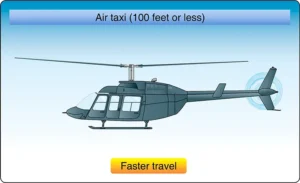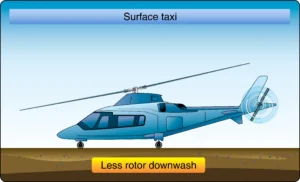Taxiing refers to operations on or near the surface of taxiways or other prescribed routes. Helicopters utilize three different types of taxiing.
Hover Taxi
A hover taxi is used when operating below 25 feet above ground level (AGL). [Figure 1]

Since hover taxi is just like forward, sideward, or rearward hovering flight, the technique to perform it is not presented here.
Air Taxi
An air taxi is preferred when movements require greater distances within an airport or heliport boundary. [Figure 2]

In this case, fly to the new location; however, it is expected that the helicopter will remain below 100 feet AGL with an appropriate airspeed and will avoid over flight of other aircraft, vehicles, and personnel.
Technique
Before starting, determine the appropriate airspeed and altitude combination to remain out of the cross-hatched or shaded areas of the height-velocity diagram. Additionally, be aware of crosswind conditions that could lead to loss of tail rotor effectiveness. Pick out two references directly in front of the helicopter for the ground path desired. These reference points should be kept in line throughout the maneuver.
Begin the maneuver from a normal hovering altitude by applying forward pressure on the cyclic. As movement begins, attain the desired airspeed with the cyclic. Control the desired altitude with the collective and rpm with the throttle. Throughout the maneuver, maintain a desired groundspeed and ground track with the cyclic, a constant heading with antitorque pedals, the desired altitude with the collective, and proper operating rpm with the throttle.
To stop the forward movement, apply aft cyclic pressure to reduce forward speed. Simultaneously lower the collective to initiate a descent to hover altitude. As forward motion stops, return the cyclic to the neutral position to prevent rearward movement. As approaching the proper hover altitude, increase the collective as necessary to stop descent at hover altitude (much like a quick stop maneuver see Rapid Deceleration or Quick Stop post).
Common Errors
- Erratic movement of the cyclic, resulting in improper airspeed control and erratic movement over the surface.
- Failure to use proper antitorque pedal control, resulting in excessive heading change.
- Failure to maintain desired altitude.
- Failure to maintain proper rpm.
- Overflying parked aircraft causing possible damage from rotor downwash.
- Flying in the cross-hatched or shaded area of the height-velocity diagram.
- Flying in a crosswind that could lead to loss of tail rotor effectiveness.
- Excessive tail-low attitudes.
- Excessive power used or required to stop.
- Failure to maintain alignment with direction of travel.
Surface Taxi
A surface taxi is used to minimize the effects of rotor downwash in wheel-type helicopters. [Figure 3]

Surface taxiing in skid type helicopters is generally not recommended due to the high risk of dynamic rollover; for more information, refer to Helicopter Emergencies and Hazards section.
Technique
The helicopter should be in a stationary position on the surface with the collective full down and the rpm the same as that used for a hover. This rpm should be maintained throughout the maneuver. Then, move the cyclic slightly forward and apply gradual upward pressure on the collective to move the helicopter forward along the surface. Use the antitorque pedals to maintain heading and the cyclic to maintain round track. The collective controls starting, stopping, and speed while taxiing. The higher the collective pitch, the faster the taxi speed; however, do not taxi faster than a brisk walk. If the helicopter is equipped with brakes, use them to help slow down. Do not use the cyclic to control groundspeed.
During a crosswind taxi, hold the cyclic into the wind a sufficient amount to eliminate any drifting movement.
Common Errors
- Improper use of cyclic.
- Failure to use antitorque pedals for heading control.
- Improper use of the controls during crosswind operations.
- Failure to maintain proper rpm.
